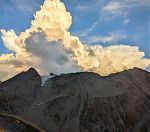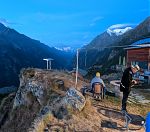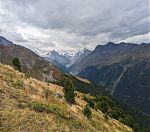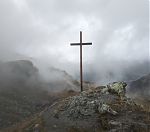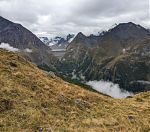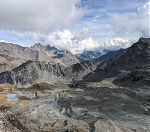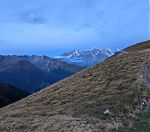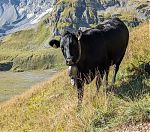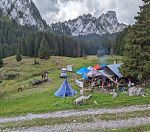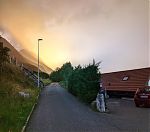7. September 2022
Swiss Peaks 360, Lessons Learned
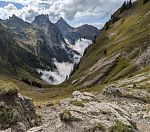 After completing the Swiss Peaks 360 foot race, it’s time to contemplate what I learnt from moving through the mountains of Valais over a distance of 360 km and a vertical gain in excess of 26,000 m, in less than 6.5 days.
After completing the Swiss Peaks 360 foot race, it’s time to contemplate what I learnt from moving through the mountains of Valais over a distance of 360 km and a vertical gain in excess of 26,000 m, in less than 6.5 days.
After nearly 152 hours past the start in Oberwald at Sunday midday, I reached the finish line in Le Bouveret at sunset. I am humbled by the experience, yet proud to have made it to the finish. Considering that 44% of the starters dropped out of the race (DNF), I must have gotten a few things right, no major thing completely wrong, and might have gotten lucky on a few occasions. It feels right to reflect, and sort things into these three categories: went well, went poorly, was lucky.
Let’s start with sleep. To be honest, when signing up, I was [obviously] the least informed about the race and did not fully understand the major role that sleep would play in a race like this. Only when preparing for the race, I understood that sleep would not be abundantly available during the Swiss Peaks 360 race.
Let’s do the maths. For a competitor like me who’s more interested in finishing at all rather than competing with other participants for rank, the anchor is the cut-off time. The cut-off for the Swiss Peaks 360 is exactly 156 hours (=6.5 days). This requires you to move at an average speed of ~2.3 km/h in order to stay within the cut-off. This average speed includes all periods of rest, refuelling includes moving over steep and technical terrain uphill and downhill. Such a requirement is thus not comparable to a flat, single road marathon where a minimum average speed of ~2.3 km/h equates to what would be an incredibly generous cut-off time of >18 hours.
Take the idea of contrasting the Swiss Peaks 360 course to a flat marathon a step further. The fastest participant in the London Marathon completes the course in a little bit over 2 hours. The cut-off for the London Marathon is at 8 hours, meaning that the slowest participant to complete the course may be 4x slower than the fastest. No wonder you can complete the London Marathon in a Big Ben costume, whilst being in the same race as Eliud Kipchoge! In comparison, the fastest participant in Swiss Peaks 360 completed the course in about 86 hours in the 2022 edition (Galen Reynolds), meaning that the slowest partcipant can only take 1.8x more time than the fastest.
There were 33 checkpoints along the route. Arguably, checkpoints are a trade-off. Every minute spent at a checkpoint is a minute spent on the spot. Every minute spent at a checkpoint however might make you faster when moving again, or might even be necessary to be able to continue moving. Still, and this is a thought on hindsight, 3 minutes extra at each checkpoint equates to about 1% of the total cut-off time.
The first night, I skipped sleep after arriving at the first life base in Fiesch (a life base is a checkpoint with additional facilities and access to the follower bag), and continued through the second stage. This seemed a common choice, and I felt that I was too wired for sleeping anyways. Whilst I did not keep track, I certainly increased the amount of sleep over the next stages, taking frequent naps of 10, 20, 30, 60 and up to 120 minutes, as the situation required it. Experimentally, sleeping longer than 2 hours at once felt like it came with diminishing returns.
Sleep is certainly one of the areas where you can make major mistakes. Attention is required on technical terrain that does not allow for major missteps. Thus, when making decisions on whether to sleep or to carry on, the safer decision is to sleep. This decision was probably harder for those participants who were moving slower than me, and who were fighting the cut-off from early on. I had a safe margin towards the cut-off throughout the race, so I could easily borrow from that margin to purchase some sleep; I did so thoroughly in Grimentz, where I slept in the life base until the very last moment allowed.
Let me illustrate what I mean: on the way to the Auberge de Salanfe, during the night, I overtook a participant who was swerving on the path from left to right. When I checked on him, he reported he was about to fall asleep. Which totally explained the swaying motion in his gait. I gave him some energy chews as the best remedy I had at hand. I was relieved to see later that he reached the Auberge de Salanfe safely. Yet, this reinforced my idea of keeping a margin [generally a good idea in the mountains!] when going from one checkpoint to the next, particularly during the night or when weather conditions are unfavourable.
Unlike other participants who napped with their running shorts and legs exposed, I get cold very quickly. I attribute this to my stature: small, lean, and thus a high surface-to-volume ratio when it comes to retaining heat in my body. I thus learned quickly to prefer checkpoints (or nice grassy bits) at lower altitude for naps, as they tend to be warmer than e.g. shelters at 2400m+ of altitude. Also, having always packed my cold kit (down jacket, hard shell trousers), I was able to add layers and make sure I would not waste energy shivering, but actually restore properly during a good bout of sleep. The other gear that turned out useful was the neck tube (“the buff”), which doubled as an eye cover during naps.
Finally, when moving through the night, the headlamp makes a big difference. Mine has three (four) different brightness levels. The lowest brightness level requires significant amount of concentration and has a similar effect like a dim reading light at bedtime. The highest brightness level illuminates the path well, but strains the battery. Bringing an additional pack of batteries to make more use of the highest brightness level may add to the comfort. I used this comfort once, but found myself with both headlamps (primary and backup) starting to become somewhat low on battery although I am fairly sure they would have lasted for a few hours; still I was lucky to be given a set of spare batteries at a checkpoint in order to rule out any remaining chance of running out of battery.
Let’s continue with food. This is an important part in the “eat, sleep, run, repeat” formula (except that I was hiking way more than running). Moving at any speed continuously over such long time, with so much vertical gain burns an incredible amount of calories. At the same time, we know that the digestive system and other systems in the body compete for energy. This makes eating a challenge during endurance events.
Unfortunately, when it came to food, I also likely made the biggest mistakes. Passing the Pic d’Artsinol, on the way to Grande Dixence, I started to feel unwell and bloated. I first thought this was due to some food I ate at a checkpoint, and that it was only a matter of choosing other foods that my digestive system would accept. However, this was not the case, and the bloated feeling stayed with me over many, many checkpoints, and in fact throughout the longest stage (Grande Dixence to Finhaut, 70 km and 4998 m elevation gain), severely limiting my wellbeing as well as my performance. In a particular low point at a particular high point (Fênetre d’Arpette), a fellow participant bailed me out with an energy gel as I had run low on such fuel by then.
Only eventually I understood that I must have overloaded my gastrointestinal system. Once I came to that realization, the remedy was crystal-clear. Reduce the load in order to restore service. I therefore added extra sleep on the approach to Morgins, and walked deliberately slowly towards Morgins, ignoring the rain, ignoring the suddenly very runnable sections on the course. With an additional amount of sleep at Morgins, I was ready to set off for the final stage to Le Bouveret. And no longer felt bloated! Ultras require problem-solving. In my case, it simply took well over 70 km to come to the critical insight (a tad too long, I find), which was not to grind through, but rather to step back, slow down, take it easy, just to come back strong again.
It’s interesting in hindsight that the performance-limiting factor was the gastrointestinal system, not the musculoskeletal system. For example, I felt no back pain, my knees were not complaining, my feet were fine (except for toenails and blisters), my muscles had something left in the tank all the way to the end. It’s unsurprising in hindsight since refuelling on long-distance journeys is certainly something I barely practiced in the run-up of the race. There you have it.
As a few rules of thumb, the lessons I draw are that I should eat more frequently, smaller portions, take more time to eat these smaller portions, and be very deliberate at checkpoints about choosing food. The staff at checkpoints is awesome: they are eager to assist you in refuelling. The staff is rightfully proud of what they are offering in remote locations (including delightfully cooked salmon, wonderfully freshly made crepe, and raclette; can you believe it?). Yet, only you know what is best for you at a given time, and even when you are in a weak spot (staff speaking to you and presenting you tasty food after hours alone in the wild), you have to be prepared to politely decline if you believe that something won’t work for you.
Let’s move on to gear (“all gear and no idea”). On a course like this, gear makes a difference. Most notably, I purchased my first set of sports glasses in the run-up to the event. These light-adaptive sunglasses turned out to be a good purchase. I had only one pair of glasses to look after. I was able to use the sunglasses during the day and during the night. The glasses sat tight on the nose, would not move around. I kept a spare set of glasses in the follower bag, just in case.
As mentioned previously, I easily get cold. It’s thus important that I can add/remove layers often, and do so quickly. Over the course of the event, if you change layers 5 times a day, you’ll have 35 layer changes. If every change of layer costs you an extra minute, you lose 35 minutes over the course of the week. So layer changes need to be efficient. In addition, layer changes should not require much cognitive load, either.
I learnt that having full-length front zippers are must haves. This way, I can add or remove the soft shell without having to pull the soft shell over my head. When carrying my cap or my headlamp, this would have added additional steps and complexity to the process. My hard shell unfortunately does not have such full-length front zipper, but any future one I will buy must have one.
I regretted not taking any gaiters with me. The many dry weeks with little rainfall rendered many of the trails sandy, with the dust being unhindered from entering my shoes and putting a fine layer of dirt over my feet. How much this aided blister formation, I don’t know. However, gaiters seem to add little weight, so why not have them.
The neck tube (“the buff”) turned out to be versatile. During hot days, it covered my ears, neck and parts of the face from the sun. I could dunk it into cold streams on the way in order to keep myself cool. During colder moments, it insulated my neck, and protected me from the wind. I’m glad that I brought multiple of these along with me.
The alternative to a neck tube for sun protection is a “trail running hoodie”. I saw a participant from the US wearing one (but no one else), and promptly asked him about it. He explained that such hoodies are commonplace, and he finds them very useful. Something to look out for in the future, I reckon.
Among the base layers I stuffed into my follower bag, the thin long-sleeve base layers turned out to be the most useful. They were not too warm during sunny days, they can be combined with long-sleeved hard shells without having the hard shell touching bare skin. The long-sleeve base layers also provide sun protection for the whole arm out-of-the-box, reducing the time and hassle spent on applying sunscreen. The short-sleeve base layers were OK, but in such an environment clearly inferior, and not as versatile.
What about the poles? The poles were definitely a useful piece of gear, but only within application areas where I had prior practice. The poles were good assistance on non-technical, long (or endless?) uphill sections. However, placement of poles requires extra cognitive load in technical terrain, and this is something I had not practiced much. I thus found it often easier during the race to stow away the poles when the terrain got technical. I was thus happy about having foldable poles, which neatly disappear in my pack when not needed.
My sports watch disappointed me. Already in stage 3, the sports watch managed to get itself into a triangle-of-death situation, where it could no longer boot after what looked like a botched system update. I was initially angry that I was now unable to track my course, unable to check the time (without extra hassle), and unable to check progress towards the next checkpoint easily. But I accepted that the sports watch only played a minor role, and I was well-equipped to move on without it. Still, in future, I will look out for options to disable any automatic software updates.
Finally, I packed portable power bank into my follower bag (the follower bag will be transported on participants’ behalf from life base to life base), which removed the need for me to find available sockets in life bases. I could just plug in my phone, my watch, and my headlamp battery into the power bank. Saves time.
To conclude, I covered a few of the areas relevant to completing the course, namely sleep, food, and gear. I have scratched on the topic of safety, but not treated other essential areas such as fitness, and motivation. But this article wasn’t meant to be an exhaustive treatment, but a selective retrospective on a massive adventure in the mountains of Valais.

